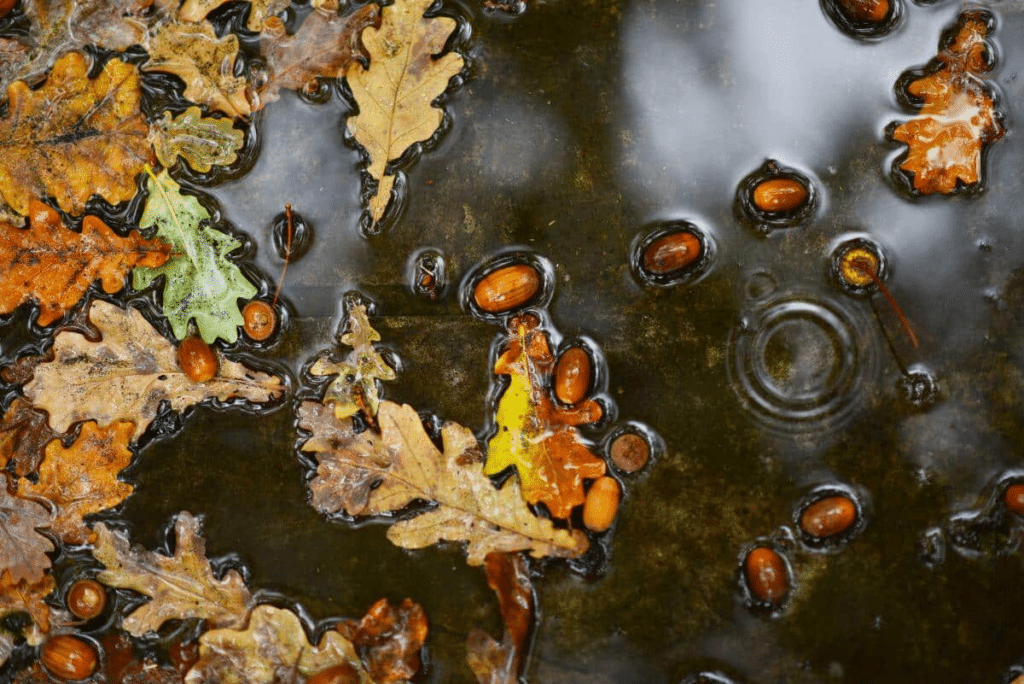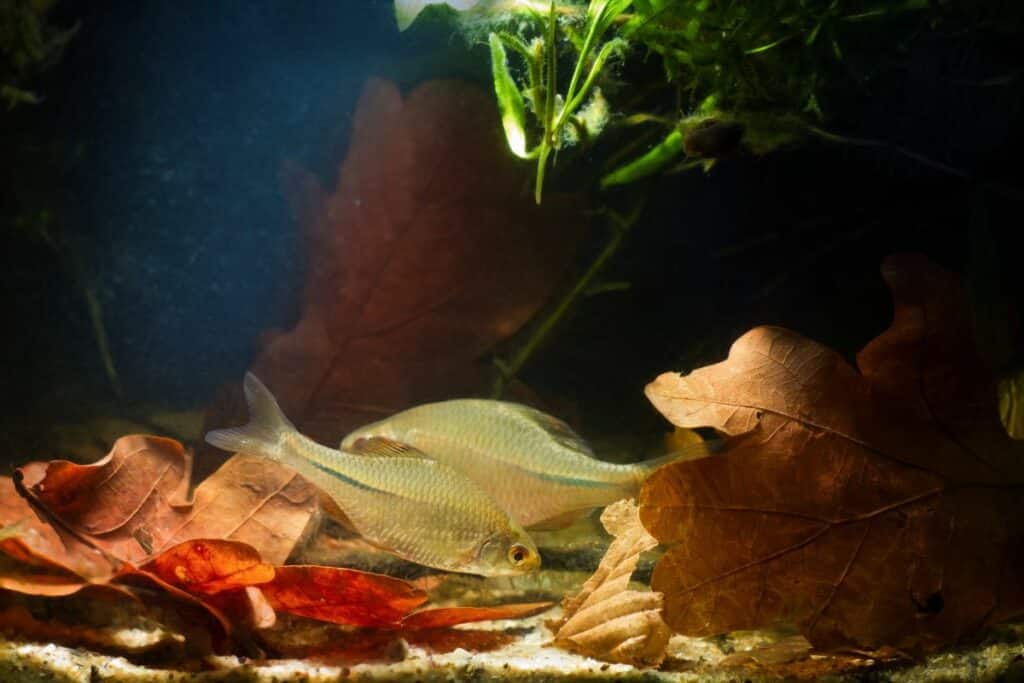the essentials in brief
Oak leaves are typically oblong-oval in shape with deep, irregular lobes along the edges. Read on here!
No, they are not harmful if they come from healthy trees and are used properly, they can even benefit the fish. Click here for more information!
Yes, oak leaves can be used as a natural decoration in the aquarium, as they give the aquarium a rustic atmosphere and provide hiding places. Here you can find more about it!
Oak leaves in the aquarium can be a fascinating and natural addition to the underwater world of your fish. Their use not only has aesthetic advantages, but can also have a positive effect on the water quality and the well-being of your aquarium inhabitants. Discover the many ways in which oak leaves can give your aquarium a very special touch.
The Oak: A majestic species of tree

The oak is an impressive species of tree found in many parts of the world. she is Known for their sturdiness, durability and imposing appearance. The oak belongs to the Quercus genus and the beech family (Fagaceae). There is worldwide more than 600 oak species, but in this section we will focus on the general characteristics of oak leaves.
The leaves of the oak - a characteristic shape
The leaves of the oak are generally large, powerful and of a distinctive shape, which is often referred to as the "oak leaf shape". The shape varies by species, but generally the leaves are oblong-oval and have deep, irregular lobes or indentations on the margins. These lobes give the leaves a jagged appearance, making them easy to distinguish from other tree species.
Different types of oak leaves
It is important to know that there are different types of oak trees and that each type has its own characteristics and variations in the leaves. Here are some examples of different oak leaves:
- Red oak (Quercus rubra): Red oak leaves have seven to eleven deep, tapering lobes. The lobes are often slightly serrated, and the upper surface of the leaf is glossy green while the underside is lighter in color.
- Pedunculate oak (Quercus robur): The pedunculate oak has elongated leaves with five to seven deep, rounded lobes. The leaves are broad and dark green at the base.
- Pedunculate oak (Quercus stellata): The leaves of the sessile oak are thick and have three to five pointed lobes. They are gray-green and have a rough texture.
Cool tips and useful hints
If you want to learn more about oak leaves, you can Look for oak trees in your area and identify the different species. There are also many Books and Online Resources, which can help you identify oak leaves.
If you oak leaves Use for crafting or decorating want it is best to collect them in the fallwhen they fall from the trees. However, make sure that you do not enter any protected or private areas and that you respect nature by only collecting a reasonable amount.
Necessary Precautions
If you collect oak leaves or are near oak trees, make sure you pick them up do not confuse it with poisonous oak (Toxicodendron radicans).. poison oak is a poisonous plant that can resemble the oak. Learn about the distinguishing features and stay away from plants that you are unsure are oak trees.
In some regions you can Oak trees attacked by the oak processionary moth become. This Caterpillars have poisonous stinging hairs that can irritate the skin, eyes or respiratory tract when touched.
Wear protective clothing such as long-sleeved shirts, long pants, closed-toe shoes, and safety goggles when in areas with oak processionary moths. Avoid staying under trees and wash your clothes thoroughly if you have been in contact with the caterpillars.
Facts about the oak
Oaks have always had a special meaning in different cultures. In Greek mythology, the oak was dedicated to Zeus, the most powerful of all gods. In many European countries, the oak symbolizes power, strength and durability. The oldest oak trees in the world are true wonders of nature. The most famous of them is the "Methuselah Oak" in the White Mountains of California, USA. It is estimated to be over 4.800 years old, making it one of the oldest living organisms on earth.
Oak leaves in the aquarium: a natural addition

Oak leaves are a popular addition to aquariums as they can create a natural and decorative environment for fish. They also have a reputation for being beneficial to the health of aquarium inhabitants. However, there are a few things to keep in mind to ensure that using oak leaves in the aquarium does not harm the fish.
Benefits of oak leaves in the aquarium
Oak leaves can enrich the aquarium in several ways:
- Natural tanning agents: Oak leaves contain tannins that are slowly released into the water. These tannins can make the water slightly acidic and produce a slight brown color. This simulates the natural conditions of many river and stream biotopes where fish often live. Many fish species that prefer soft and acidic water feel particularly comfortable in an aquarium designed in this way.
- Antibacterial and fungicidal effect: The tannins in oak leaves may also have antibacterial and fungicidal properties. This can help improve water quality by inhibiting the growth of harmful bacteria and fungi. It is believed that this provides a healthier environment for the fish.
- Protection and hiding place: Oak leaves offer the fish hiding places and protection from predators or stress caused by too much visual contact. Oak leaves can create a sheltered space where they feel safe, especially for smaller species of fish or juvenile fish.
Precautions and Notes
Although using oak leaves in the aquarium can offer many benefits, there are a few precautions and tips to keep in mind:
- Origin of the oak leaves: It is important to ensure that the oak leaves used are clean and free of any chemicals or contaminants. It's best to use leaves from untreated trees that have not been collected near busy roads or other potentially polluted areas.
- Preparation of the oak leaves: Before adding the oak leaves to the aquarium, they should be rinsed thoroughly to remove dirt, insects or other debris. It's also a good idea to boil the leaves briefly or douse them with hot water to kill any harmful bacteria or parasites that may be present.
- Water quality monitoring: Since the oak leaves can make the water slightly acidic, it is important to regularly monitor the water quality, especially the pH level. Make sure the water parameters match the needs of your fish species to avoid unwanted effects on their health.
Note: In nature, oak leaves are used by many species of fish as part of their natural environment. It is known that certain fish, such as catfish or shrimp, use oak leaves as a food source or prefer them as a place to lay their eggs and raise their young.
Oak Leaves as Aquarium Decoration: Natural Beauty

Oak leaves are a wonderful way to decorate the aquarium in a natural way. They give the aquarium a rustic and organic atmosphere and offer many benefits to the aquarium inhabitants. Here you can find out more about their use as decoration in the aquarium.
Advantages of oak leaves as a decoration
There are several advantages to using oak leaves as an aquarium decoration:
- Aesthetics: Oak leaves add natural beauty to the aquarium and create an authentic environment. Their autumnal appearance with the characteristic shapes and warm colors gives the aquarium a pleasant atmosphere.
- hiding places: Oak leaves offer fish places to hide and retreat. Especially for shy or sensitive fish species, they can create a safe space and help them feel more comfortable and secure.
- Biofilms and Food: Oak leaves promote the growth of microorganisms and biofilms. These serve as a natural food source for many aquarium inhabitants such as shrimp or certain types of fish. By grazing on the biofilms, they contribute to the ecological balance in the aquarium.
Note: Oak leaves are widely used in the art of aquascaping to create stunning and lifelike underwater landscapes. With clever placement and arrangement, they can imitate the natural habitat in the aquarium and create a fascinating atmosphere.
More than just decoration
The use of oak leaves in aquariums can both aesthetic and functional benefits offer. Create your natural beauty and atmosphere an authentic environment for the aquarium inhabitants.
In addition, offer oak leaves Hides, promotes the growth of microorganisms and can serve as a natural source of food. However, it is important to use high-quality leaves, prepare them properly, and monitor water quality to avoid adverse effects on fish.


